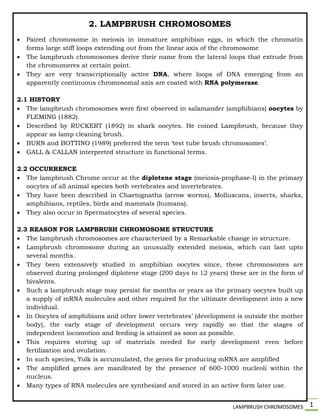
LAMPBRUSH CHROMOSOMES
- 1. LAMPBRUSH CHROMOSOMES 1 2. LAMPBRUSH CHROMOSOMES Paired chromosome in meiosis in immature amphibian eggs, in which the chromatin forms large stiff loops extending out from the linear axis of the chromosome The lampbrush chromosomes derive their name from the lateral loops that extrude from the chromomeres at certain point. They are very transcriptionally active DNA, where loops of DNA emerging from an apparently continuous chromosomal axis are coated with RNA polymerase. 2.1 HISTORY The lampbrush chromosomes were first observed in salamander (amphibians) oocytes by FLEMING (1882). Described by RUCKERT (1892) in shark oocytes. He coined Lampbrush, because they appear as lamp cleaning brush. BURN and BOTTINO (1989) preferred the term ‘test tube brush chromosomes’. GALL & CALLAN interpreted structure in functional terms. 2.2 OCCURRENCE The lampbrush Chrome occur at the diplotene stage (meiosis-prophase-I) in the primary oocytes of all animal species both vertebrates and invertebrates. They have been described in Chaetognatha (arrow worms), Molluscans, insects, sharks, amphibians, reptiles, birds and mammals (humans). They also occur in Spermatocytes of several species. 2.3 REASON FOR LAMPBRUSH CHROMOSOME STRUCTURE The lampbrush chromosomes are characterized by a Remarkable change in structure. Lampbrush chromosome during an unusually extended meiosis, which can last upto several months. They been extensively studied in amphibian oocytes since, these chromosomes are observed during prolonged diplotene stage (200 days to 12 years) these are in the form of bivalents. Such a lampbrush stage may persist for months or years as the primary oocytes built up a supply of mRNA molecules and other required for the ultimate development into a new individual. In Oocytes of amphibians and other lower vertebrates’ (development is outside the mother body), the early stage of development occurs very rapidly so that the stages of independent locomotion and feeding is attained as soon as possible. This requires storing up of materials needed for early development even before fertilization and ovulation. In such species, Yolk is accumulated, the genes for producing mRNA are amplified The amplified genes are manifested by the presence of 600-1000 nucleoli within the nucleus. Many types of RNA molecules are synthesized and stored in an active form later use.
- 2. LAMPBRUSH CHROMOSOMES 2 Thus, lampbrush chromosomes are ~30 times less condensly packed. In late-meiosis, the Chromosomes revert to their usual compact size. 2.4 STRUCTURAL ORGANISATION Each RNA polymerase molecule is attached to nascent RNA and associated proteins, generating a visible “brush-like” appearance. During diplotene stage, the lampbrush chromosomes are held in a stretched-outform which can be visualized in a light microscope. The axis of lampbrush chromosomes, from which the loops project, consist visually of linear arrays of compacted beads, series of ellipsoidal chromomeres. They are meiotic bivalents (maternal & paternal). Each bivalent consists of two homologous chromosomes (4 chromatids) held together by chiasmata. ~ 1 to 2 u m in diameter which are connected by a very thin thread. The length of the individual lampbrush chromosomes may sometimes become even larger than giant salivary gland chromosomes. The largest length measures 1 mm, observed in few amphibians. Length of this Chromosome in the newt (Notophthalumus Viridescens) range from 400 to 800 um compared with the range of 15 to 20 um seen dates in meiosis. The total length of the entire lampbrush chromosomes is 5-6 mm and is organised into ~5000 chromomeres.
- 3. LAMPBRUSH CHROMOSOMES 3 LOOPS The loops are always symmetrical, each chromosomes having two of them one for each chromatid. The centromeres of the chromosomes bear no loops. About 10,000 loops per chromosome set or haploid set. The size of loops varies with an average of 4-5µ in inter chromomeric fibers. About 5-10% of DNA exists in the lateral loops, the rest being tightly condensate in the chromomeres which are transcriptionally inactive. The size of loop increases with the genome size. Each loop has an axis made up of single DNA molecule that is unfolded from the chromosome during RNA synthesis. 2.5 TRANSCRIPTION IN LOOP Electron microscope of the loops has shown that RNA polymerase molecules are attached to the principal axis (DNA) of the loop from which RNA fibrils of increasing length extends. Each loop of Lampbrush chromosome is found to perform intense transcription of hnRNA that is precursors for of mRNA molecules for various ribosomal proteins/cytoplasmic ribosomes, histone protein. Each lateral loop is covered by a matrix that consists of RNA transcripts with hnRNA (Heterogeneous RNA molecules) binding protein attached to them. RNA synthesis starts at the thinner end and progresses towards the thicker end. Generally, then matrix is asymmetrical, being synthesis starts at one end of the loop than at the other. The loops can be categorized by size thickness and other morphological characteristics. As transcription continues the DNA strand loop, the fibril of RNA that is hnRNA lengthens. Protein gets associated with these RNA fibrils as they are formed and ultimately ribo- nucleoprotein product is released. Actin filaments may be involved in extending the lampbrush chromosomal loop away from the chromomeric axis. As meiosis proceeds further, the number of loops gradually decreases and the loops ultimately disappear due to reabsorption back into the chromosomes. 2.6 BIOLOGICAL SIGNIFICANCE Loops are used in chromosome mapping, especially each loop which appears at a constant point in the Chromosome. Lampbrush chromosome would be extremely useful to visualize gene expression in its natural state and enables to observe changes are associated with transcription. Lampbrush chromosome provides evidence for eukaryotic gene amplification which is required during the growth phase of oocytes. They are very good material for hybridization analysis.
